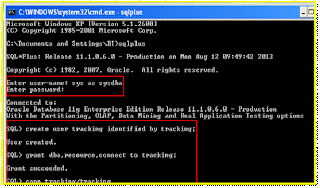Usage Tracking which is used to monitor the query performance and the users or group of users who was seen the dashboards or reports.
Analyzing usage details by users, groups and queries requested by the user.
The detail report of log in time and logout time, time of period used by the user in a dashboard, and query analyses.
Useful information of user’s information for billing process by enabling usage tracking.
Step by step Implementation of usage tracking
Create a schema for usage tracking (It’s not mandatory, you can use the already existed schema also).
Creating a new schema using sqlplus.
Open a command prompt, login as sys.
For example,
Create username as “tracking” and password as “tracking”.
Grant permissions to the user.
 Execute the SAACCT.Oracle.sql from the following location “start <obiee 10 installed drive>\oracleBI\Server\Schema\ SAACCT.Oracle.sql “in the command prompt.
Execute the SAACCT.Oracle.sql from the following location “start <obiee 10 installed drive>\oracleBI\Server\Schema\ SAACCT.Oracle.sql “in the command prompt.
Example:
Sql> start c:\ oracleBI\Server\Schema\ SAACCT.Oracle.sql and give enter.
Table and index will create.
Check whether the tables and indexes were created or not, by exploring the command “DESC S_NQ_ACCT;”
Run the quote in the command prompt of sql.
You can see the table with list of columns.
Stop the presentation services, by going to services.msc in run prompt.
Stop the service and check the oracle Bi presentation server stopped.
Go to control panel to create a ODBC connection between BI admin tool and database for newly created schema “tracking”.
Start à control panelà Administrative tools à Microsoft ODBC Administrator
ODBC Data Source Administrator Dialogue box will open to add the DSN connectivity.
Go to system DSN tab to create an ODBC Connectivity.
Click on add button to add the tracking connectivity between database and admin.
A dialogue box will open to give credentials of the schema.
A list of drivers name will get display select the appropriate driver for the data source, here we are going to select “Oracle in oraDb11g_home2”.
According to the database installed in system the drivers may differ.
Give configuration credentials to make the connection.
As per the dialogue box appear when click on “Oracle in oraDb11g_home2”.
Data Source Name: tracking (user defined)
Description: tracking (user defined)
TNS Service Name: vijai (user defined According to the tns file)
User ID: tracking
Click on test connection, to test the connection made correct or not.
After click on the test connection, give the password credentials for the schema we created.
Once the connection successful click ok.
You can see the “tracking” will be added in the system dsn list.
Open the BI Admin Tool in offline mode,
Click on file and choose the option Import à from Database
Select Data source which we are going to import, choosing here as “OCI 11g/10g”
Change the connection type to OCI 11g/10 by drop down in the connection type.
Give the credentials,
TNS Name: vijai
User Name: tracking
Password: tracking
Click ok.
An import of the table dialogue box will open, select the appropriate table and import and give the credentials for connection pool.
Select the tracking table under that check the tables…
Click import and close.
Give the connection pool name and the schema name and password.
Connection Pool Name: tracking
Call Interface: OCI11g/10g
Data Source Name: vijai
User name: tracking
Password: tracking
Click ok.
After importing check in physical layer, whether the table is imported or not.
Create an alias for that table with the name of Alias_S_NQ_ACCT(User Defined)
Join the original table and alias table.
Joining columns are user_name
Drag and Drop the tracking folder to BMM layer and also Presentation Layer.
Check the consistency and save.
Go to the OBIEE 10 Installed folder
<installed folder>\OracleBI\server\Config\NQSConfig.INI
Edit the NQSConfig.INI file, by opening in notepad.
Go to the section of Usage tracking, Change the option from no to yes.
And go the other section, Parameters for inserting into table.
Give the credentials for the database to get link with bi admin tool.
Change the credentials to,
Physical_table_name = “vijai”.”Tracking”.”S_NQ_ACCT”;
Connection_Pool = “vijai”.”tracking”;
Click save and close.
Then restart the services.
Go to sql developer and make a new connection with the user “tracking”
Connection Name: tracking
Username: tracking
Password: tracking
Hostname: local host
Port: 1521
SID: orcl
Click test connection and connect.
Check the Tables imported or not in the database
Check the data in database for the table.
Go to presentation side, login and view the dashboards and reports then check the database.
View the reports, the time and user will affect in the database.
We will get the information which user logged in and seeing what reports.
Create one report using the tracking schema.
Click ok to see report.


































Comments
Post a Comment